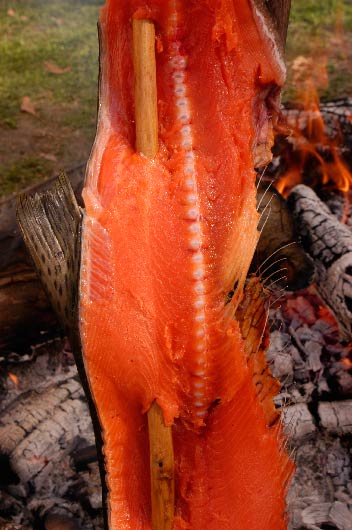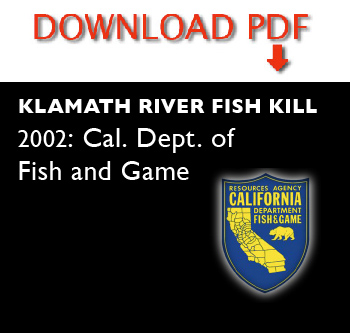Out, out, damn dams
From The Bear Deluxe magazine: June 2009
Molli Jane White, a Karuk Indian from the banks of the beleaguered Klamath River, says her husband, Leaf Hillman, drove four hours (one way) last September in order to ask the Yuruk Tribe in Happy Camp, Calif. for two salmon so that the Karuk would have a few forkfuls of fish to offer tribal members during their annual salmon renewal ceremony. White, 26, appreciates the irony, she says, but she’d rather see PacifiCorp, which operates four hydroelectric dams along a 300-mile stretch of the Klamath in Southern Oregon and Northern California, eat concrete. So to speak. At the present moment, she is vying for mike time at the annual Berkshires Hathaway, Inc. shareholders meeting in Omaha, Neb. where Warren Buffet, PacifiCorp’s billionaire owner, leads his flock and their stock through green valleys.

She says she’d like to thank PacifiCorp for signing the Nov. 14, 2008 Agreement in Principle to remove the dams, but would be happier with less promises and more salmon. She and members of the Hoopa, Karuk and Yurok tribes are again crashing the Berkshires’ meeting, which they’ve done every year, clamoring for dam destruction, since 2002, when low flows, high temperatures and water quality were the prime suspects in the “gill rot” deaths of an estimated 79,000 adult salmon, according to the California Department of Fish and Game. Coho salmon in the Klamath River are listed as threatened under the U.S. Endangered Species Act, and pink and chum salmon are extinct.
PacifiCorp signed the agreement, along with the State of California, the State of Oregon, and the U.S. Department of the Interior, after an independent study by the Federal Energy Regulatory Commission found it would cost PacifiCorp more to retrofit four dams with fish ladders (to comply with federal salmon-management plans and current law), than it would to just yank them.

The agreement spawned the 26-member (depending on how you count them), Klamath Basin Settlement Group, which has until June 30 this year to figure out how to pull the plug on the dams.
Glen Spain, Northwest Regional Director of the Pacific Coast Federation of Fishermen’s Associations—a party to the agreement—described the negotiations as “probably the most intractable problem in any basin in the U.S.” Spain notes that the group is working under a gag rule, and can’t give many details other than that he and others who want the dams removed are tired of “lurching from crisis to crisis” on the Klamath. In addition to satisfying Indians, farmers, rate payers, legislators, biologists, lobbyists and Warren Buffet, the group must also pen the devil’s details into the 2008 Klamath River Restoration Agreement, which avows a reclamation of the 8,000 square-mile watershed, which is only 5.18 times larger than Rhode Island.
Spain says that prior to the FERC study, the California Energy Commission (CEC) “concluded that it was much more cost effective to both the company and the ratepayers to just tear them down than to try to patch them up—$114 million cheaper, in fact, based on mid-line estimates of future power costs and value of electricity. This one-two economic study whammy from the CEC and then FERC certainly had an impact on PacifiCorp’s thinking.”
The Klamath discord was recently featured in a German film titled Upstream Battle, which features a woodpecker-murdering Indian trailing a kayak behind an SUV while railing against American capitalists, in an effort to clarify the issues for the general public. Director Ben Kempas says, “I’d like to tell myself that the documentary influenced the company’s decision to enter an Agreement in Principle … However, you need to understand that this agreement is the result of years and years of tough negotiations.”
He also notes that the film gave PacifiCorp officials “new insight into tribal ways of life.” Prospects for uprooting the dams improved Feb. 17 with the passage of Senate Bill 76 in the Oregon State Senate, by an 18-12 vote.
Proposed by Oregon Governor Ted Kulongoski, the bill limits the economic ‘burden’ of removal. PacifiCorp’s 550,000 Oregon ratepayers are expected (according to the utility) to see a monthly rate hike of no more than $1.80 in order to collect $180 million over the next 11 years. Californians, who host three of the four dams, would have to cover an additional $250 million through bond sales.
Michael Carrier, Kulongoski’s natural resource policy director, says the Klamath Basin Restoration Agreement would consume $1 billion over 10 years, 40 percent of which he believes would come from the U.S. Department of Agriculture and other federal agencies in money already coming to the basin. He adds that Oregon has dedicated 7.5 percent of the state’s lottery earnings to watershed restoration, and a piece of that can easily be invested in reclaiming the Klamath—assuming the Basin team ditches the dams.
Spain says, “We’re busting our assess to come to a settlement.”
The breakneck pace of the negotiations is somewhat ironic, given that the U.S. Secretary of Interior has until March 2012 to make a “go-no go decision” on whether the dams die, observes Spain.
“It takes several years for permitting and design to take down a dam. The actual wrecking ball [if indeed there is one] will be targeted for 2020. Between now and then, until the messiah comes, we need to do everything we can to limit the damage to salmon.” The End
04/22/11 | Comments | Out, out, damn dams